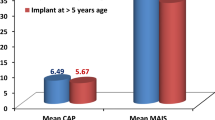Abstract
Background
Cochlear nerve deficiency is one of the known causes of congenital sensorineural hearing loss. Management of hearing loss in children with cochlear nerve deficiency poses a multidimensional challenge. The absent or hypoplastic cochlear nerve may prevent electrical stimulation from reaching the brainstem and the auditory cortex. A deficient cochlear nerve can be associated with other inner ear malformations, which may diminish the success of cochlear implantation in those children. Promising results in adults after auditory brainstem implantation led to the expansion of candidacy to include the pediatric populations who were contraindicated for CIs.
Objective
To review the outcomes of cochlear implantation versus that of auditory brainstem implantation in children with various conditions of the auditory nerve.
Methods
This retrospective chart review study comprised two pediatric groups. The first group consisted of seven ABI recipients with cochlear nerve aplasia and the second group consisted of another seven children with cochlear nerve deficiencies who underwent CI surgery. The participants’ auditory skills and speech outcomes were assessed using different tests selected from the Evaluation of Auditory Responses to Speech (EARS) test battery.
Results
There were some individual variations in outcomes depending on the status of the auditory nerve. The mean CAP score of the ABI group was 2.87, while the mean SIR score was 0.62. On the other hand, the mean CAP score of the CI group was 1.29, while the mean SIR score was 0.42.
Conclusion
Our results are in good agreement with the reported auditory perception and speech and language development outcomes of pediatric auditory brainstem implantation. We added to the growing body of literature on the importance of verifying and identifying the status of the cochlear nerve in the decision-making process of the surgical management of those pediatric groups.
Similar content being viewed by others
References
Deep NL, Roland JT Jr (2020) “Auditory brainstem implantation: candidacy evaluation, operative technique, and outcomes.” Otolaryngol Clin North Am 53(1):103–113. https://doi.org/10.1016/j.otc.2019.09.005
Glastonbury CM, Davidson HC, Harnsberger HR, Butler J, Kertesz TR, Shelton C (2002) “Imaging findings of cochlear nerve deficiency.” AJNR Am J Neuroradiol 23(4):635–643
Bayazit YA et al (2014) “Methods and preliminary outcomes of pediatric auditory brainstem implantation.” Ann Otol Rhinol Laryngol 123(8):529–536. https://doi.org/10.1177/0003489414525123
Merkus P et al (2014) “Indications and contraindications of auditory brainstem implants: systematic review and illustrative cases.” Eur Arch Otorhinolaryngol 271(1):3–13. https://doi.org/10.1007/s00405-013-2378-3
Noij KS et al (2015) “Systematic review of nontumor pediatric auditory brainstem implant outcomes.” Otolaryngol Head Neck Surg 153(5):739–750. https://doi.org/10.1177/0194599815596929
Wu CM, Lee LA, Chen CK, Chan KC, Tsou YT, Ng SH (2015) Impact of cochlear nerve deficiency determined using 3-dimensional magnetic resonance imaging on hearing outcome in children with cochlear implants. Otol Neurotol 36(1):14–21
Teagle HFB, Henderson L, He S, Ewend MG, Buchman CA (2018) “Pediatric auditory brainstem implantation: surgical, electrophysiologic, and behavioral outcomes.” Ear Hear 39(2):326–336. https://doi.org/10.1097/aud.0000000000000501
Rajeswaran R, Kameswaran M (2020) “Auditory brainstem implantation (ABI) in children without neurofibromatosis type II (NF2): communication performance and safety after 24 months of use.” Cochlear Implant Int 21(3):127–135. https://doi.org/10.1080/14670100.2019.1690264
Sennaroğlu L et al (2016) “Consensus statement: long-term results of ABI in children with complex inner ear malformations and decision making between CI and ABI.” Cochlear Implant Int 17(4):163–171. https://doi.org/10.1080/14670100.2016.1208396
Govaerts PJ et al (2002) Outcome of cochlear implantation at different ages from 0 to 6 years. Otol Neurotol 23(6):885–890. https://doi.org/10.1097/00129492-200211000-00013
Colletti L, Zoccante L (2008) “Nonverbal cognitive abilities and auditory performance in children fitted with auditory brainstem implants: preliminary report.” Laryngoscope 118(8):1443–1448. https://doi.org/10.1097/MLG.0b013e318173a011
Faes J, Gillis S (2019) “Auditory brainstem implantation in children with hearing loss: effect on speech production.” Int J Pediatr Otorhinolaryngol 119:103–112. https://doi.org/10.1016/j.ijporl.2019.01.014
Kutz JW Jr, Lee KH, Isaacson B, Booth TN, Sweeney MH, Roland PS (2011) “Cochlear implantation in children with cochlear nerve absence or deficiency.” Otol Neurotol 32(6):956–61. https://doi.org/10.1097/MAO.0b013e31821f473b
Acknowledgements
The authors are grateful to the Deanship of Scientific Research, King Saud University, for providing funding through the Vice Deanship of Scientific Research Chairs. This research project was recommended by the Saudi Otorhinolaryngology Society. The authors would like to thank Wilnelia Adams for her help in editing the paper.
Funding
There are no funders to report for this submission.
Author information
Authors and Affiliations
Corresponding author
Ethics declarations
Conflict of interest
The authors declare that they have no conflict of interest.
Ethical approval
Ethical approval was obtained by the Local Ethical Committee. All procedures performed in studies involving human par- ticipants were in accordance with the ethical standards of the institutional and/or national research committee and with the 1964 Helsinki Declaration and its later amendments or comparable ethical standards.
Informed consent
Written consent was taken from all participants included in the study.
Additional information
Publisher's Note
Springer Nature remains neutral with regard to jurisdictional claims in published maps and institutional affiliations.
Rights and permissions
About this article
Cite this article
Yousef, M., Mesallam, T.A., Almasaad, A. et al. Cochlear implantation versus auditory brainstem implantation in children with auditory nerve deficiencies. Eur Arch Otorhinolaryngol 279, 1295–1300 (2022). https://doi.org/10.1007/s00405-021-06792-8
Received:
Accepted:
Published:
Issue Date:
DOI: https://doi.org/10.1007/s00405-021-06792-8




